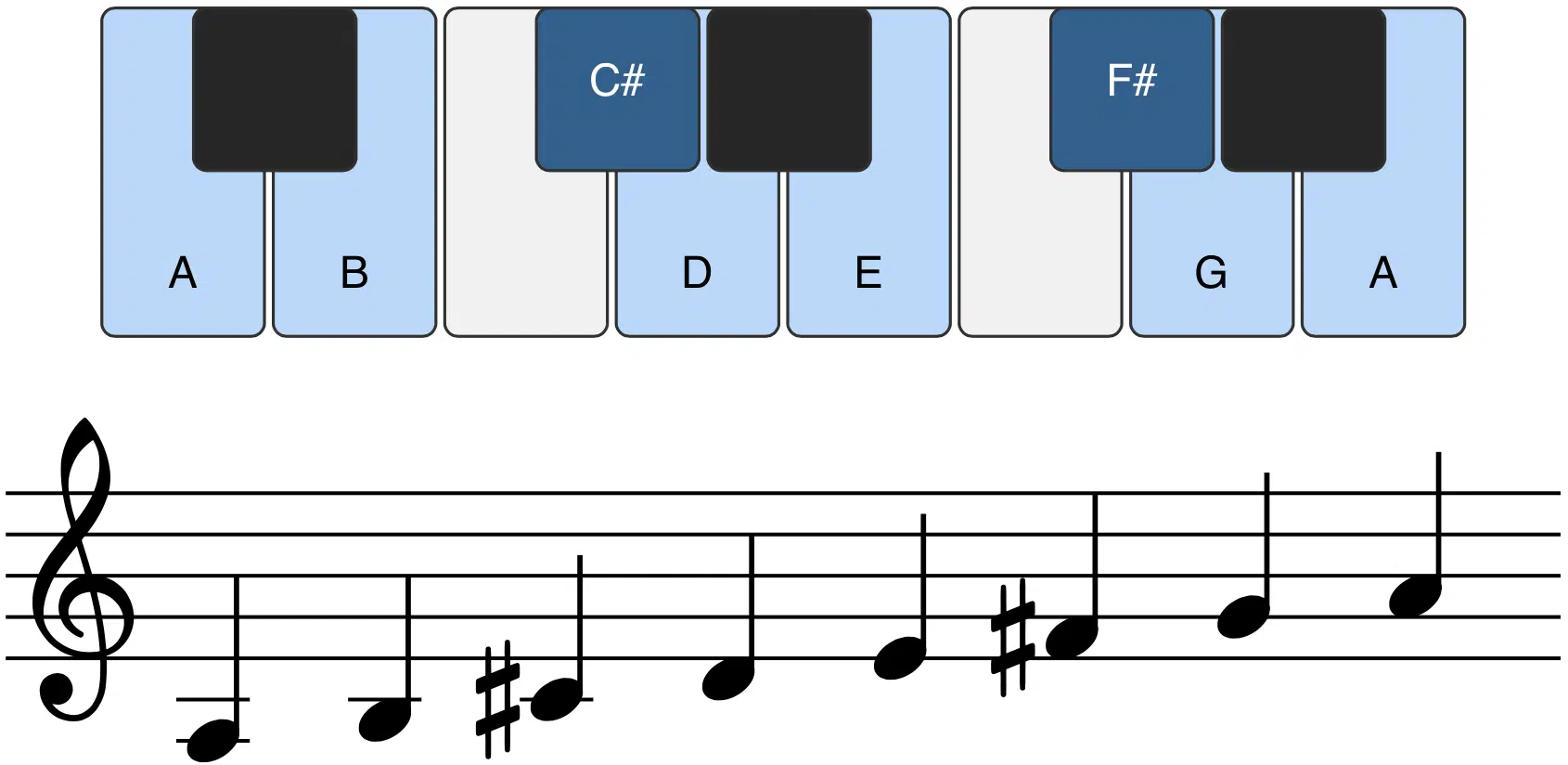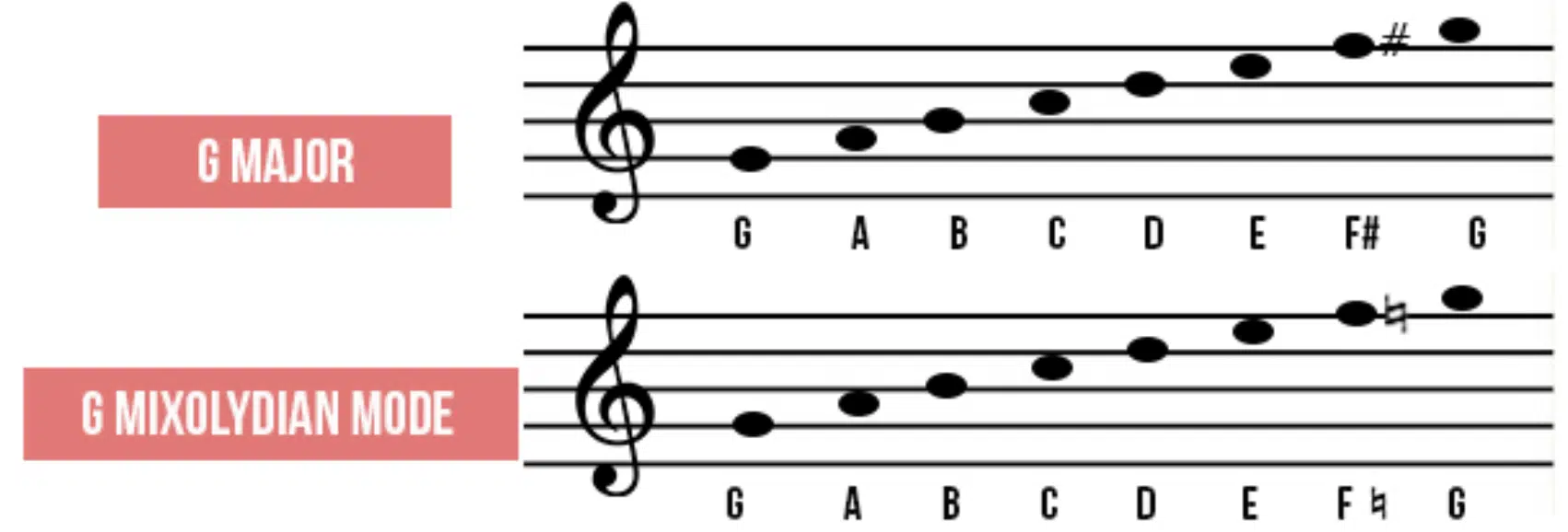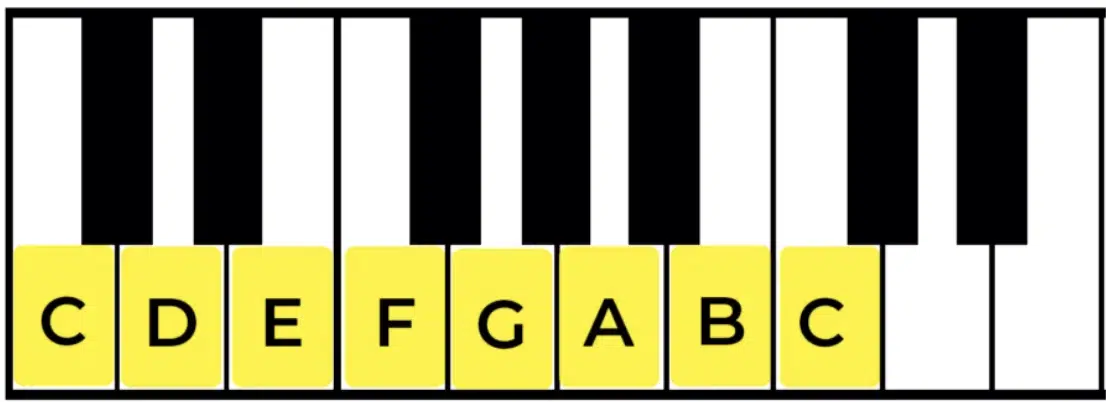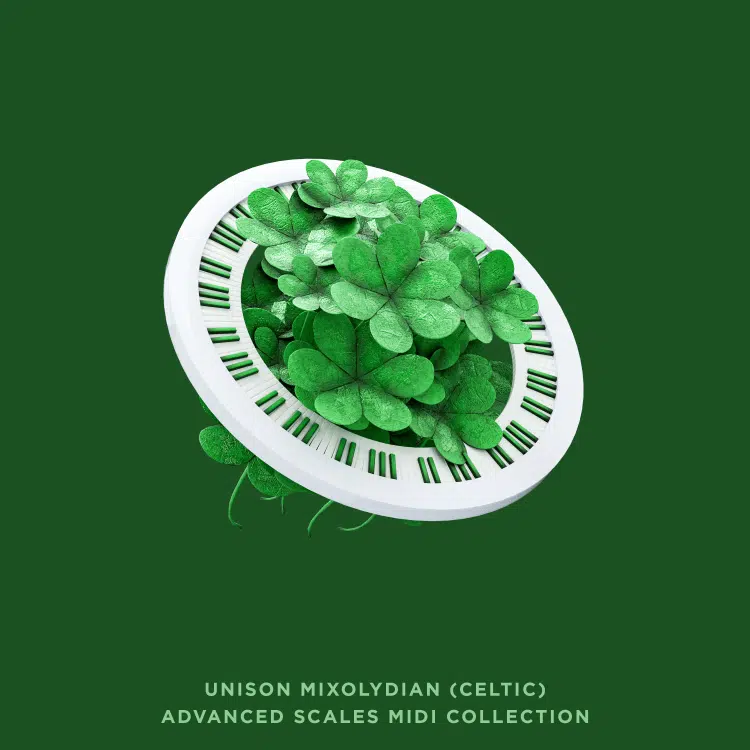The Mixolydian scale is a musical treasure trove, rich in harmonic possibilities and unique tonal qualities.
It can infuse songs with a blend of major brightness and minor-like depth and offer a fresh perspective on melody and harmony.
Plus, serves as a bridge between various musical styles.
As a music producer, understanding the Mixolydian scale is essential for crafting dynamic and emotionally resonant tracks that stand out.
In today’s article, we’ll break down:
- The Mixolydian scale ✓
- Unique characteristics of the Mixolydian mode ✓
- It’s comparison with major scales ✓
- Chord progressions and extensions ✓
- Practical applications in digital music ✓
- Creative manipulations and improvisations ✓
- Analyzing Mixolydian with other musical modes ✓
- Practical tips for using Mixolydian in your own music ✓
- Much more ✓
By the end of this article, you’ll possess an all-encompassing understanding of the Mixolydian scale, empowering you to experiment and innovate like a professional.
You’ll be equipped with the knowledge to weave the Mixolydian scale into your compositions 一 adding depth, complexity, and a unique sonic signature to your music.
So, let’s dive in…
Table of Contents
- The Mixolydian Scale: Breaking it Down
- Distinct Characteristics of the Mixolydian Mode
- The Structure of the Mixolydian Scale
- Comparing Mixolydian with Major Scales
- Exploring Chords in the Mixolydian Mode
- Analyzing Mixolydian with Other Musical Modes
- Bonus: The Unison Mixolydian (Celtic) Advanced Scales MIDI Collection
- Final Thoughts
The Mixolydian Scale: Breaking it Down

The Mixolydian scale, a cornerstone in the world of music theory, stands out as a unique and versatile tool for digital music producers.
At its core, this scale is a variant of the major scale, distinguished primarily by one critical modification: the flattened seventh note.
This alteration gives the Mixolydian scale a distinct sound, setting it apart from the more conventional major scale.
Understanding this scale is crucial for anyone looking to add a fresh, captivating sound to their music, especially in genres like:
- Rock music
- Jazz
- Modern electronic music
- Even video game music
To fully grasp how the Mixolydian works, it’s essential to delve into its structure and how it compares to other musical scales and modes.
Don’t worry, we’ll cover all of that in this complete guide.
The Mixolydian scale consists of seven notes, with the sequence typically starting on the fifth degree of a major scale.
For example, the G Mixolydian scale is derived from the C Major scale, containing the same notes but starting from G.
This unique starting point (the fifth note) creates a sound that is both familiar and intriguingly different 一 offering a blend of major brightness and minor depth.
The Mixolydian scale shines in its ability to inject a sense of tension and release in musical compositions.
This characteristic makes it a favorite among digital music producers who aim to create emotionally resonant and dynamically rich pieces.
Its versatility allows it to adapt seamlessly across various musical styles.
Distinct Characteristics of the Mixolydian Mode

Diving deeper into the characteristics of the Mixolydian mode, one finds that its unique tonal quality stems from the interplay between its notes.
The flattened seventh degree plays a pivotal role in defining the mode’s sound.
This one note being altered creates a subtle yet profound shift from the bright and resolved sound of a major scale to something more complex and intriguing.
This mix of major and minor qualities allows the Mixolydian mode to convey a range of emotions, like:
- Joyful
- Upbeat
- Introspective
- Melancholic
It’s this versatility that has made the Mixolydian mode a staple in genres as diverse as rock music, blues, and jazz improvisation.
This is because it adds color and depth to melodies and harmonies.
In the realm of digital music production, the Mixolydian mode offers a palette of sounds that can enhance the emotional impact of a track.
The Mixolydian mode’s appeal also lies in its compatibility with various chord progressions and harmonic structures.
Unlike more rigid scales, the Mixolydian mode can adapt to different harmonic contexts 一 offering music producers a wealth of creative possibilities.
The Structure of the Mixolydian Scale
The Mixolydian scale’s structure is both simple and complex, offering a gateway to a myriad of musical expressions. Its foundational elements lie in its root notes and scale degrees, each contributing to its distinctive sound.
-
Notes and Scale Degrees in Mixolydian

At the heart of the Mixolydian scale are its notes and scale degrees, which form the basis of its unique tonal quality.
Each note in the scale plays a specific role, contributing to the overall sound and feel of this music mode.
For example, in the G Mixolydian scale, the notes are G, A, B, C, D, E, and F.
All the notes follow a pattern similar to the major scale but with the critical difference of the flattened seventh degree (F in this case).
Understanding the function of each scale degree is crucial for music producers looking to utilize the Mixolydian scale effectively.
- The first degree, or the root note, establishes the tonal center of the scale.
- The third degree determines the major quality.
- The flattened seventh introduces a touch of the minor scale’s complexity.
This interplay of major and minor elements (like the minor third) is what gives the Mixolydian scale its unique appeal and versatility.
-
The Flattened Seventh: A Key Element

The flattened seventh note is arguably the most defining characteristic of the Mixolydian scale.
This single alteration from the major scale creates a distinct sound that is immediately recognizable.
In the G Mixolydian scale, the seventh note is F, as opposed to the F# found in the G Major scale.
This small change has a significant impact on the scale’s overall character 一 imparting a slightly more relaxed and bluesy feel.
The flattened seventh also plays a crucial role in chord construction within the Mixolydian mode.
It often leads to the creation of dominant seventh chords, which are fundamental in many musical styles, particularly in jazz and blues.
These chords, built using the root, major third, perfect fifth, and flattened seventh notes, provide a sense of tension and resolution, a cornerstone in musical storytelling.
Comparing Mixolydian with Major Scales
As we transition into comparing the Mixolydian scale with major scales, it becomes evident that these subtle differences have profound impacts on musical expression.
-
Mixolydian vs. Major Scale: Understanding the Differences

The primary distinction between the Mixolydian scale and the major scale lies in their respective seventh scale degrees.
In the major scale, this seventh degree is a major seventh, a half-step from the tonic chord, creating a sense of completeness and resolution.
NOTE: A half-step is one semitone.
In contrast, the Mixolydian scale uses a flattened seventh, which is a whole step from the tonic 一 lending a more open-ended and unresolved quality to the scale.
This difference might seem minor on paper, but in practice, it significantly alters the mood and harmonic possibilities.
Your audience will listen to, hear, and appreciate this shift.
- The Major scale is often associated with feelings of happiness and resolution.
- The Mixolydian scale with its flattened seventh, on the other hand, brings a more complex, sometimes melancholic or edgy vibe.
This quality makes the Mixolydian scale a favorite for music producers looking to add depth and character to their tracks.
The Mixolydian scale’s structure allows for more fluid and dynamic chord progressions, unlike the more predictable progressions often found in major scales.
-
G Mixolydian and C Major Scale

To illustrate the differences between Mixolydian and major scales, let’s compare the G Mixolydian scale with the C Major scale.
While both scales share the same notes – G, A, B, C, D, E, F – their tonal centers differ.
The G Mixolydian scale starts on G, while the C Major scale begins on C; this difference in starting points results in distinct sonic qualities.
The C Major scale is bright and conclusive, often used in popular music that seeks to convey happiness and triumph.
The G Mixolydian scale, with its G tonal center and flattened seventh (F), offers a more complex sound, suitable for conveying a broader range of emotions.
For digital music producers, understanding these nuances is key to creating emotional beats.
The choice between a G Mixolydian scale and a C Major scale can significantly impact the mood and direction of a piece, just take a listen for yourself.
Exploring Chords in the Mixolydian Mode
The exploration of chords within the Mixolydian mode opens up a vast landscape of harmonic possibilities, essential for the modern music producer.
-
Chord Progressions in Mixolydian

Chord progressions using the Mixolydian scale often include dominant chords from the dominant scale, which are pivotal in creating tension and resolution in music.
Playing these progressions provides a rich harmony for various musical styles, especially in genres where emotional expression is key, like jazz.
For example, a common chord progression in the G Mixolydian mode might involve moving:
- From a G7 chord (G, B, D, F).
- To a C major chord (C, E, G).
This chord progression highlights the Mixolydian mode’s unique characteristic 一 the interplay between the dominant chord (seventh) and the resolution to a major chord.
It creates a sound that is familiar and intriguing, which your listeners will hear and love.
In digital music production, a chord progression like this, from the early days, offers a framework for building captivating and emotionally resonant tracks.
NOTE: Exploring the E F G sequence in the G Mixolydian scale, and its relation to the F G A B notes, highlights its role as the fifth mode.
This is particularly true in the creation of the V chord in chord progressions.
-
Creative Use of Chord Extensions

Beyond basic chords, the Mixolydian mode also lends itself well to the use of chord extensions, adding depth and color to harmonic structures.
These extensions can be used to create more complex and sophisticated chords, like:
- The ninth
- The eleventh
- The thirteenth
In the context of the G Mixolydian scale, incorporating these extensions can result in chords like G9 (G, B, D, F, A) or G11 (G, B, D, F, C).
These extended chords offer a richer harmonic texture, crucial for music producers aiming to craft intricate, layered songs.
Analyzing Mixolydian with Other Musical Modes
When analyzing the Mixolydian mode alongside other musical modes, a wealth of creative possibilities emerges. Using all the modes is particularly relevant for enriching your own music with diverse harmonic textures; simply play around with them.
-
The Ionian Mode

The Ionian mode (commonly known as the major scale) is the epitome of stability and brightness in the realm of musical modes.
When playing Mixolydian, which shares several notes with the Ionian mode, you can observe a subtle yet significant shift in mood.
This is due to the Mixolydian scale’s flattened seventh note (not a raised sixth).
That single note change adds a layer of complexity and a slightly unresolved feel compared to the complete resolution found in the Ionian mode, not so much other modes.
-
The Phrygian Mode

In contrast, the Phrygian mode, with its minor second and minor sixth, offers a darker and more exotic tonal landscape.
Playing Mixolydian in conjunction with the Phrygian mode can highlight the brighter, more uplifting nature of the Mixolydian mode.
The contrast between these modes can be creatively used in your own music to create passages that shift from a sense of tension in Phrygian to a more resolved and upbeat Mixolydian sound.
Exploring the notes of these modes in detail reveals their characteristics and how they contribute to the overall sound.
In the Mixolydian mode, the notes create a balance between major brightness and minor-like depth.
In the Ionian mode, the notes form a sequence that feels complete and conclusive.
Meanwhile, the Phrygian mode’s notes introduce a sense of mystery and intrigue (often associated with Middle Eastern and Spanish music flavors).
Bonus: The Unison Mixolydian (Celtic) Advanced Scales MIDI Collection

Dive into the world of Mixolydian scales with the Unison Mixolydian (Celtic) Advanced Scales MIDI Collection.
It’s a comprehensive resource offering over 1,100+ Mixolydian-scale-specific MIDI chords, progressions, and melodies.
This collection is designed to make your music stand out, providing an effortless way to incorporate high-quality Mixolydian elements into your tracks.
Ideal for both beginners and seasoned producers, these MIDI files are ready to use right away, offering an instant boost to your musical creativity.
You can also customize them to your heart’s content, editing or transposing the notes to fit your unique style and preferences.
This Collection is more than just a convenience 一 it’s a revolutionary pack that eliminates the need for extensive music theory knowledge.
By giving you direct access to meticulously crafted melodic elements, it empowers you to create music that truly resonates with the distinct sound of the Mixolydian scale.
Whether you’re crafting a Celtic-inspired piece or infusing your electronic beats with this mode’s unique flavor, this collection opens up new horizons for your musical expression.
It will ensure your beats are not just heard but remembered.
Final Thoughts
The Mixolydian scale is more than just an academic exercise; it’s a crucial step in your journey as a music producer.
Understanding the Mixolydian scale, with its unique blend of major and minor qualities, opens up a world of creative possibilities.
It allows you to craft music that is both emotionally resonant and technically sophisticated.
By diving deep into its structure, comparing it with other scales, and exploring its applications, you can now transform your musical ideas into captivating tracks.
Remember, the Mixolydian scale is not just a set of notes; it’s a tool for artistic expression.
Whether you’re composing a melody, creating a chord progression, or designing a complex harmony, the insights gained from this article will help you create legendary music.
The Unison Mixolydian (Celtic) Advanced Scales MIDI Collection further enhances this journey, providing you with the resources to immediately apply your newfound knowledge.
As you continue to experiment and create with the Mixolydian scale, keep in mind the power of this mode to evoke emotions and build memorable musical experiences.
Until next time…







Leave a Reply
You must belogged in to post a comment.